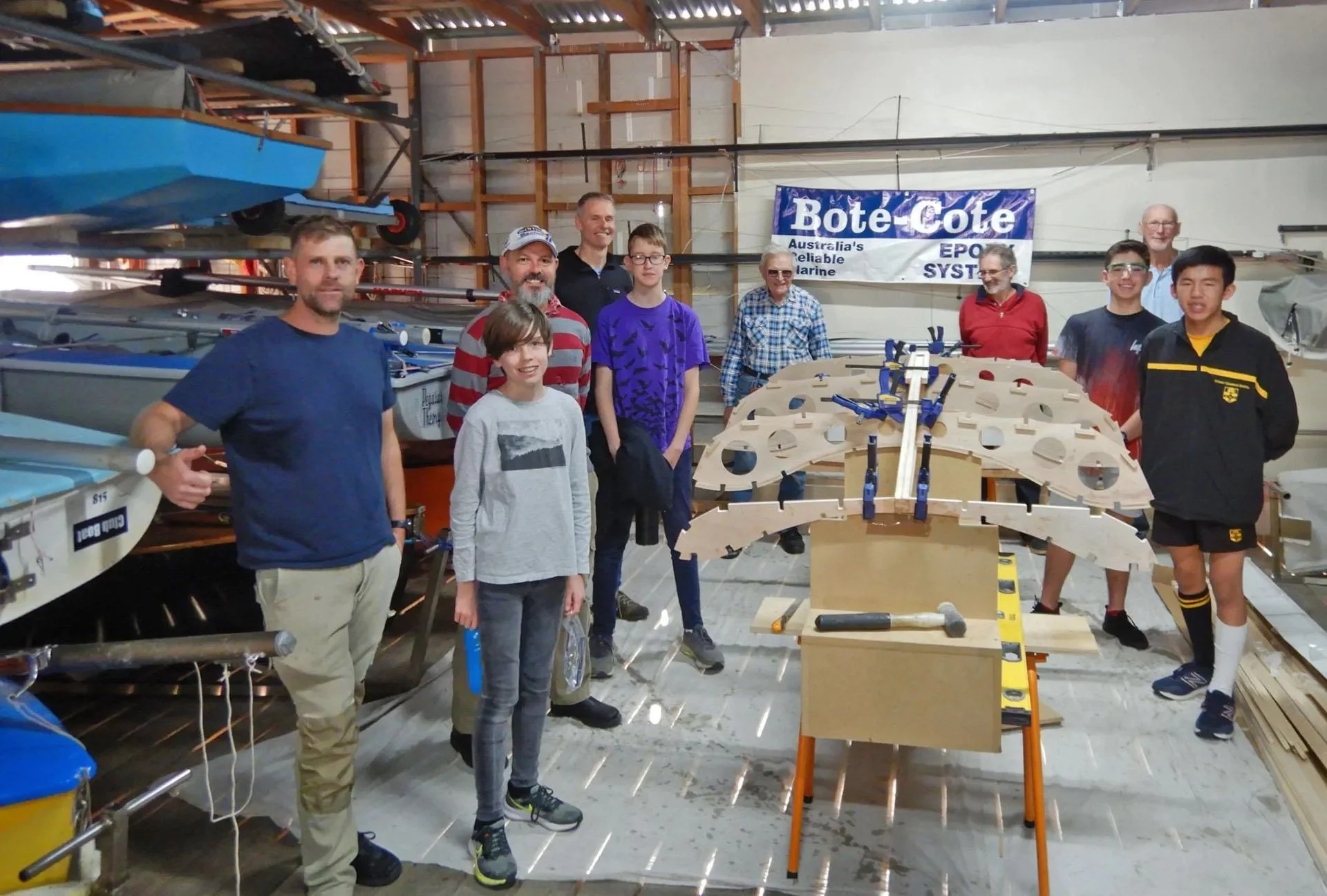Somewhere over the Rainbow
From John Fairfax at the Australian Classic Dinghy Network
The Rainbow designed in 1940 sailing at Adelaide’s Brighton & Seacliff YC 1955
John Fairfax sailing Rainbow NAUTI-GAL at Chelsea 2022. Photo Mark Chew
Last Thursday 12th December, something special in the history of classic dinghies happened on the sparkling waters of Corio Bay in Geelong. The first Rainbow to be built in Victoria in close to fifty years was officially launched at the Western Beach Boat Club, itself a hidden treasure tucked away at the western end of the Geelong waterfront.
Rainbow class yachts appealed to youngsters because they could build one themselves, they were fast and thrilling to sail, cheap to build, and safe with good buoyancy compartments. In Southern states they outnumbered the popular Sydney VJ’s. Rainbows were controlled in Australia by the National Rainbow Council with affiliated clubs in Victoria, South Australia, Western Australia, New South Wales, Queensland and Tasmania. The Rainbows built in the early fifties had wooden masts, booms and cotton sails costing all up £75 including a set of plans & two lifebelts. By 1960 over 100 were registered in Tasmania. “When it is considered that no concerted effort had been made to popularize the class, we can only attribute its popularity to the low cost of construction combined with unexcelled sailing capabilities (speed & safety) of this grand little craft.” In the early sixties most Rainbow hulls were built for around $60 with Dacron sails costing $120, many young amateurs built their own boat and were sailing an extremely fast, competitive boat, for under $300.
The Rainbow, STICKY BEAK, is the latest one to be built under the Making Waves Foundation’s Wright of Passage program. Shane Grevis, who is the main driving force behind the Rainbow building program, travelled down from Sydney just for the launch. This wonderful program is well established at Concord Ryde SC in Sydney and has already expanded to Newcastle, Brisbane and now Geelong. A number of other clubs in Melbourne are also interested in participating.
Next February a brand new fully rigged Rainbow will be on display at the Hobart City Hall in our classic dinghy exhibition as part of the Australian Wooden Boat Festival 7-10 February. As part of an already spectacular display of classic dinghies, another Rainbow will be built, so visitors can see the process and meet the hardworking volunteers from the Wright of Passage program.
Don’t forget that the Rainbow on display will be raffled to raise money to expand the building program. This is a link to the raffle where you can buy your raffle tickets. Please consider contributing to this wonderful and worthwhile project:
And this segues nicely into an article published Sail World this week entitled “Make Me Smile” written by John Curnow
Rainbow no 2 for Wright of Passage launched 11 Dec 2024. Photo Concord and Ryde SC
Francesca Grevis sails her new Imperium Moth. Photo Concord and Ryde SC
The dwindling support for youth sailing highlighted in the earlier article has left many clubs facing the existential crisis of aging membership and the potential loss of critical mass. Ross Venner from the Concord and Ryde SC said, '‘we are constrained by a lease that bans facilities such as restaurants. Clearly, we have to go in a different direction.’ Compounding these challenges, Venner pointed out another problem. ‘We are located in an area with rapid population growth and some economic stress, we have to be relevant to the whole of our community.’
To say he had clearly elucidated his thoughts is an understatement, and the clarity of vision driving the mission is so wonderfully compelling and engaging. Venner added, "80% of the pupils in some local primary schools are from first generation immigrant families. Of course they place a high emphasis on academic achievement. That is the right thing for them to do. Our challenge is to be relevant in this educational paradigm without adding to economic pressures. We identified key skills which are hard for schools to impart, but were familiar to the senior generation of dinghy sailors through building boats from wood."
"What skills? Manual dexterity of course, enhanced through the proper use of, and importantly, care for, good quality tools. The reading of plans and building instructions to convert the designer's ideas into fully functional sailing craft. Then carrying out these real-world tasks in a team of disparate young people."
In ye olde days these may have been dismissed as 'life skills' or 'holding a degree from the University of Hard Knocks.' Today, the lack of such skills can be an impediment to the progress of a significant number of school leavers.
Day one boat one with Moth team. Photo Concord and Ryde SC
Moth structure before decking - photo Concord and Ryde SC
The planning that underpins this program is impressive. Even the selection of two scow dinghies to build shows real forethought. The Rainbow is simple ply chine construction, while the Imperium Moth delivers some nice curved shapes. The double handed Rainbow needs on-water teamwork while the Moth invites more independent sailors. They are both stable in light winds for a novice but can be powered up to keep the developing sailor engaged. In summary, if you want to be a skilful surgeon, mastering strategy and console control with Warcraft is good but building a scow and learning to sail is great.
Following the publication of the article above Martin Ryan (Ex CYAA President contacted us with this observations and pictures.
“A great characteristic is that they can carry their kites to Windward, pointing just as high… the best exponent of this in my era was Peter Gale from Chelsea YC, World OK’s in ‘81 and top Couta sailor.”














